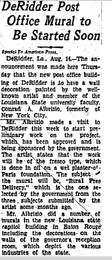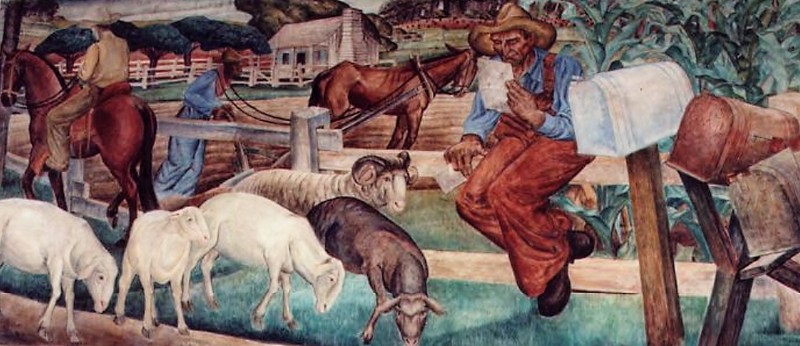"Rural Free Delivery" Depression-era fresco/Old Post Office
Introduction
Text-to-speech Audio
This fascinating piece of art can be seen at the former Post Office, across from the Beauregard Parish Courthouse, U.S. 171 eastbound, in DeRidder. The fresco was completed in 1936 by the late Louisiana artist, Conrad Albrizio. He was considered the dean of American fresco artists.
Images
An old newspaper article outlining the mural's commission.

"Rural Free Delivery"

Backstory and Context
Text-to-speech Audio
With the advent of technology providing internet and e-mail capabilities, one cannot help but recall the initial provisions for the mail delivery as a means of keeping in touch.
Such authority for mail delivery was placed in the U.S. Constitution in 1789, when Congress was granted the authority to establish post offices in the United States.
Prior to the 1900s, government buildings were built in the style supervised by the Treasury Department’s supervising architect. As the Great Depression began, the government expanded its public works program to stimulate the economy. With almost one-third of the unemployed hailing from the building trades, the government's public works was able to expand its presence through distinctive architecture and artwork which embellished the interiors of the structures.
The primary sponsor of artwork in federal buildings was the Treasury Department's Section of Painting and Sculpture (later known as Section of Fine Arts). At least one percent of a building's construction was funded for artwork.
Artists were selected through blind competition and employed standards of stylistic realism in their depictions of everyday American life. More than 1,100 post offices were decorated in this manner and often represented a community's only exposure to quality artwork. Twenty-three Louisiana postal facilities were among those decorated with Section artwork.
Section artwork was intended to depict an accurate representation of local life. It included the requirement that artists visit the town in which their commission would be located prior to submitting proposed sketches. These murals and other artworks are considered the private property of the Postal Service.
DeRidder can indeed boast of having one of the former postal facilities that is among the 17 buildings that remain in Louisiana that are decorated with artwork. The fresco, which graces the lobby of the former Post Office, was completed in 1936 by the late Louisiana artist, Conrad Albrizio. He was considered the dean of American fresco artists.
Albrizio was the first artist in the region to do true frescoes-that is, painting scenes on wet plaster. His painting methods date back many centuries. He was commissioned for murals in post offices around the South by the Works Progress Administration (WPA) in the 1930s. Conservative symbolism was used by Albrizio. With its vivid colors and imagery, the mural in DeRidder depicts people and customs that shaped the South. It is also of interest that in the early 1930s, Albrizio was commissioned to create a mural for Huey P. Long's new state Capitol in Baton Rouge.
The DeRidder fresco, "Rural Free Delivery," has the distinction of being selected as an image appearing in "Louisiana: AN ILLUSTRATED HISTORY, Louisiana Purchase Bicentennial Edition, 2003." (SOURCE: City of DeRidder)
Such authority for mail delivery was placed in the U.S. Constitution in 1789, when Congress was granted the authority to establish post offices in the United States.
Prior to the 1900s, government buildings were built in the style supervised by the Treasury Department’s supervising architect. As the Great Depression began, the government expanded its public works program to stimulate the economy. With almost one-third of the unemployed hailing from the building trades, the government's public works was able to expand its presence through distinctive architecture and artwork which embellished the interiors of the structures.
The primary sponsor of artwork in federal buildings was the Treasury Department's Section of Painting and Sculpture (later known as Section of Fine Arts). At least one percent of a building's construction was funded for artwork.
Artists were selected through blind competition and employed standards of stylistic realism in their depictions of everyday American life. More than 1,100 post offices were decorated in this manner and often represented a community's only exposure to quality artwork. Twenty-three Louisiana postal facilities were among those decorated with Section artwork.
Section artwork was intended to depict an accurate representation of local life. It included the requirement that artists visit the town in which their commission would be located prior to submitting proposed sketches. These murals and other artworks are considered the private property of the Postal Service.
DeRidder can indeed boast of having one of the former postal facilities that is among the 17 buildings that remain in Louisiana that are decorated with artwork. The fresco, which graces the lobby of the former Post Office, was completed in 1936 by the late Louisiana artist, Conrad Albrizio. He was considered the dean of American fresco artists.
Albrizio was the first artist in the region to do true frescoes-that is, painting scenes on wet plaster. His painting methods date back many centuries. He was commissioned for murals in post offices around the South by the Works Progress Administration (WPA) in the 1930s. Conservative symbolism was used by Albrizio. With its vivid colors and imagery, the mural in DeRidder depicts people and customs that shaped the South. It is also of interest that in the early 1930s, Albrizio was commissioned to create a mural for Huey P. Long's new state Capitol in Baton Rouge.
The DeRidder fresco, "Rural Free Delivery," has the distinction of being selected as an image appearing in "Louisiana: AN ILLUSTRATED HISTORY, Louisiana Purchase Bicentennial Edition, 2003." (SOURCE: City of DeRidder)
